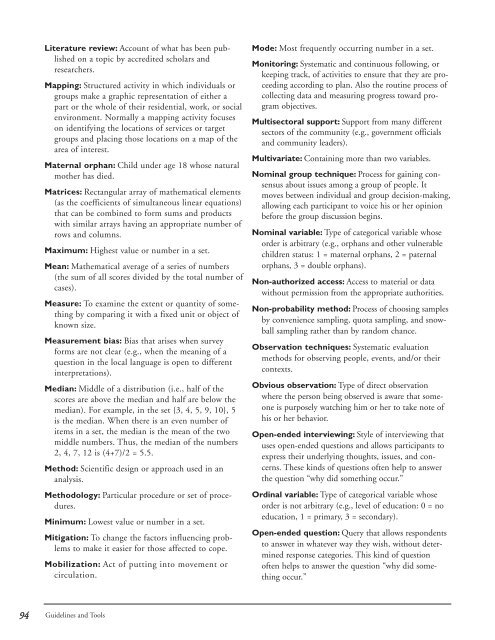Conducting a Participatory Situation Analysis of.pdf - Global HIV ...
Conducting a Participatory Situation Analysis of.pdf - Global HIV ...
Conducting a Participatory Situation Analysis of.pdf - Global HIV ...
You also want an ePaper? Increase the reach of your titles
YUMPU automatically turns print PDFs into web optimized ePapers that Google loves.
Literature review: Account <strong>of</strong> what has been published<br />
on a topic by accredited scholars and<br />
researchers.<br />
Mapping: Structured activity in which individuals or<br />
groups make a graphic representation <strong>of</strong> either a<br />
part or the whole <strong>of</strong> their residential, work, or social<br />
environment. Normally a mapping activity focuses<br />
on identifying the locations <strong>of</strong> services or target<br />
groups and placing those locations on a map <strong>of</strong> the<br />
area <strong>of</strong> interest.<br />
Maternal orphan: Child under age 18 whose natural<br />
mother has died.<br />
Matrices: Rectangular array <strong>of</strong> mathematical elements<br />
(as the coefficients <strong>of</strong> simultaneous linear equations)<br />
that can be combined to form sums and products<br />
with similar arrays having an appropriate number <strong>of</strong><br />
rows and columns.<br />
Maximum: Highest value or number in a set.<br />
Mean: Mathematical average <strong>of</strong> a series <strong>of</strong> numbers<br />
(the sum <strong>of</strong> all scores divided by the total number <strong>of</strong><br />
cases).<br />
Measure: To examine the extent or quantity <strong>of</strong> something<br />
by comparing it with a fixed unit or object <strong>of</strong><br />
known size.<br />
Measurement bias: Bias that arises when survey<br />
forms are not clear (e.g., when the meaning <strong>of</strong> a<br />
question in the local language is open to different<br />
interpretations).<br />
Median: Middle <strong>of</strong> a distribution (i.e., half <strong>of</strong> the<br />
scores are above the median and half are below the<br />
median). For example, in the set {3, 4, 5, 9, 10}, 5<br />
is the median. When there is an even number <strong>of</strong><br />
items in a set, the median is the mean <strong>of</strong> the two<br />
middle numbers. Thus, the median <strong>of</strong> the numbers<br />
2, 4, 7, 12 is (4+7)/2 = 5.5.<br />
Method: Scientific design or approach used in an<br />
analysis.<br />
Methodology: Particular procedure or set <strong>of</strong> procedures.<br />
Minimum: Lowest value or number in a set.<br />
Mitigation: To change the factors influencing problems<br />
to make it easier for those affected to cope.<br />
Mobilization: Act <strong>of</strong> putting into movement or<br />
circulation.<br />
Mode: Most frequently occurring number in a set.<br />
Monitoring: Systematic and continuous following, or<br />
keeping track, <strong>of</strong> activities to ensure that they are proceeding<br />
according to plan. Also the routine process <strong>of</strong><br />
collecting data and measuring progress toward program<br />
objectives.<br />
Multisectoral support: Support from many different<br />
sectors <strong>of</strong> the community (e.g., government <strong>of</strong>ficials<br />
and community leaders).<br />
Multivariate: Containing more than two variables.<br />
Nominal group technique: Process for gaining consensus<br />
about issues among a group <strong>of</strong> people. It<br />
moves between individual and group decision-making,<br />
allowing each participant to voice his or her opinion<br />
before the group discussion begins.<br />
Nominal variable: Type <strong>of</strong> categorical variable whose<br />
order is arbitrary (e.g., orphans and other vulnerable<br />
children status: 1 = maternal orphans, 2 = paternal<br />
orphans, 3 = double orphans).<br />
Non-authorized access: Access to material or data<br />
without permission from the appropriate authorities.<br />
Non-probability method: Process <strong>of</strong> choosing samples<br />
by convenience sampling, quota sampling, and snowball<br />
sampling rather than by random chance.<br />
Observation techniques: Systematic evaluation<br />
methods for observing people, events, and/or their<br />
contexts.<br />
Obvious observation: Type <strong>of</strong> direct observation<br />
where the person being observed is aware that someone<br />
is purposely watching him or her to take note <strong>of</strong><br />
his or her behavior.<br />
Open-ended interviewing: Style <strong>of</strong> interviewing that<br />
uses open-ended questions and allows participants to<br />
express their underlying thoughts, issues, and concerns.<br />
These kinds <strong>of</strong> questions <strong>of</strong>ten help to answer<br />
the question “why did something occur.”<br />
Ordinal variable: Type <strong>of</strong> categorical variable whose<br />
order is not arbitrary (e.g., level <strong>of</strong> education: 0 = no<br />
education, 1 = primary, 3 = secondary).<br />
Open-ended question: Query that allows respondents<br />
to answer in whatever way they wish, without determined<br />
response categories. This kind <strong>of</strong> question<br />
<strong>of</strong>ten helps to answer the question “why did something<br />
occur.”<br />
94<br />
Guidelines and Tools















